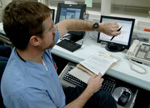Omnivision, Oacis speed document selection
by Emerald Communications and Training CommitteePicture Dr. Data as he prepares to meet with Mr. Patient: he logs into Oacis to read the latest lab and radiology results, then logs out of Oacis. The latest clinic orders need to be reviewed, however, requiring Dr. Data to log into Omnivision, the document imaging component of MUSC’s electronic medical record project. He searches for Mr. Patient’s scanned images, then selects the appropriate physician order sheet. Following review of the scanned document, Dr. Data is prepared to meet with Mr. Patient.

Photo by MUSC Art Services and Digital Imaging
Dr. Laurence Raney, Emergency Services, checks
the time as he selects a document with the Omnivision feature in Oacis.
Thanks to the combined efforts of CCIT, the Omnivision vendor, Lanvision, and Health Information Services, Dr. Data’s process of preparation has been simplified considerably by eliminating the need to access two separate systems. A scanned document may now be viewed directly from Oacis as a result of the Oacis Image Enablement project initiated early last year. The main objective of the project is to provide direct access to Omnivision from Oacis, thus eliminating the steps of logging into another program, searching for a patient, then searching for a document’s scanned image.
What documents are being scanned?
Health Information Services initiated document scanning in 1999 as
reported in a previous article available from The Catalyst online archives
http://www.musc.edu/catalyst/archive/2000/co9-8document.htm.
Document scanning, or document imaging, has been expanded to include the
following departments: hematology/oncology clinics and inpatient areas;
radiation oncology; adult sickle cell program; obstetrics exam visits;
general emergency and pediatric emergency departments; pediatric neonatology
inpatient areas; pediatric cardiology and surgery inpatient areas; pediatric
general and critical care inpatients; pediatric surgery, nephrology, sickle
cell, and adolescent medicine outpatient areas; pediatric day treatment
outpatient; and send out lab results. Documents considered “loose materials”
such as consents, correspondence or consultations are also scanned. Approximately
10,000 pages a day are processed, or scanned, into Omnivison.
Documents scanned in January to present have been loaded into Oacis. Documents scanned in previous years will be “backloaded” in reverse chronological order. The fourth quarter, 2001, will soon be available from Oacis.
How does the integration work?
When a document is scanned into Omnivision, it is assigned a unique
“reference number.” This reference number is electronically sent to Oacis
along with the patient name, medical record number, a document type and
document date of service. Oacis “loads” the reference number into the patient’s
electronic chart, displaying a “row,” or result, on a list available through
a roster column. Roster columns configured for Omnivison are prefaced with
the terms “Scan” or “Scanned.” Users are encouraged to add the roster column
called “Scanned Document Menu” to their rosters; it provides access to
all scanned roster columns. The menu list of categories is consistent with
those set up in Omnivision. The row, or result, is available on a list
loaded under each category.
How do I access this information in Oacis?
Dr. Data reviews Mr. Patient’s lab and radiology results. Instead of
logging into Omnivision to view a physician order sheet, he adds the “Scanned
Document Menu” roster column to his roster. He’ll then double click on
the display code for the roster column to open the scan menu, scroll through
the document categories to “ScanOrders,” then double click on the display
code for it to show a list of orders that have been scanned for Mr. Patient.
Dr. Data selects the physician order sheet from the list, which causes
the Omnivision viewer to “launch,” displaying the single document selected.
Functionality facts to remember:
A critical requirement for image enablement to function properly is
the availability of the Omnivision icon from the computer’s desktop. Without
Omnivision on the computer, attempts to “launch” the viewer from Oacis
will generate error messages.
Users familiar with Omnivision functions or features will discover some limitations if using Oacis to launch the viewer; for security reasons, access to scanned documents from Oacis is limited to only the document selected from the list displayed on the roster. Users are reminded that an audit trail of results accessed via Oacis is documented with each transaction. This audit trail includes access to scanned documents.
The ability to launch the Omnivision viewer from Oacis is not currently available via citrix, or webapps.
Final thoughts:
This development provides “one-stop shopping” service—enabling the
Omnivision viewer to be launched from Oacis has eliminated the need to
log into a second application, thus saving Dr. Data and his colleagues
valuable time. Remember to check for the Omnivision icon before attempting
to access a scanned document image via Oacis!
If you experience problems accessing scanned documents from Oacis call the CCIT Help Desk at 792-9700.
For more information regarding the document imaging project, please contact Tom Holley, resource information coordinator, Health Information Services, holleyt@musc.edu
For more information regarding Image Enablement from Oacis, contact Deb Campbell, R.N., clinical systems analyst, CCIT, campbeld@musc.edu.
Catalyst Online is published weekly, updated as
needed and improved from time to time by the MUSC Office of Public Relations
for the faculty, employees and students of the Medical University of South
Carolina. Catalyst Online editor, Kim Draughn, can be reached at 792-4107
or by email, catalyst@musc.edu. Editorial copy can be submitted to Catalyst
Online and to The Catalyst in print by fax, 792-6723, or by email to petersnd@musc.edu
or catalyst@musc.edu. To place an ad in The Catalyst hardcopy, call Community
Press at 849-1778.